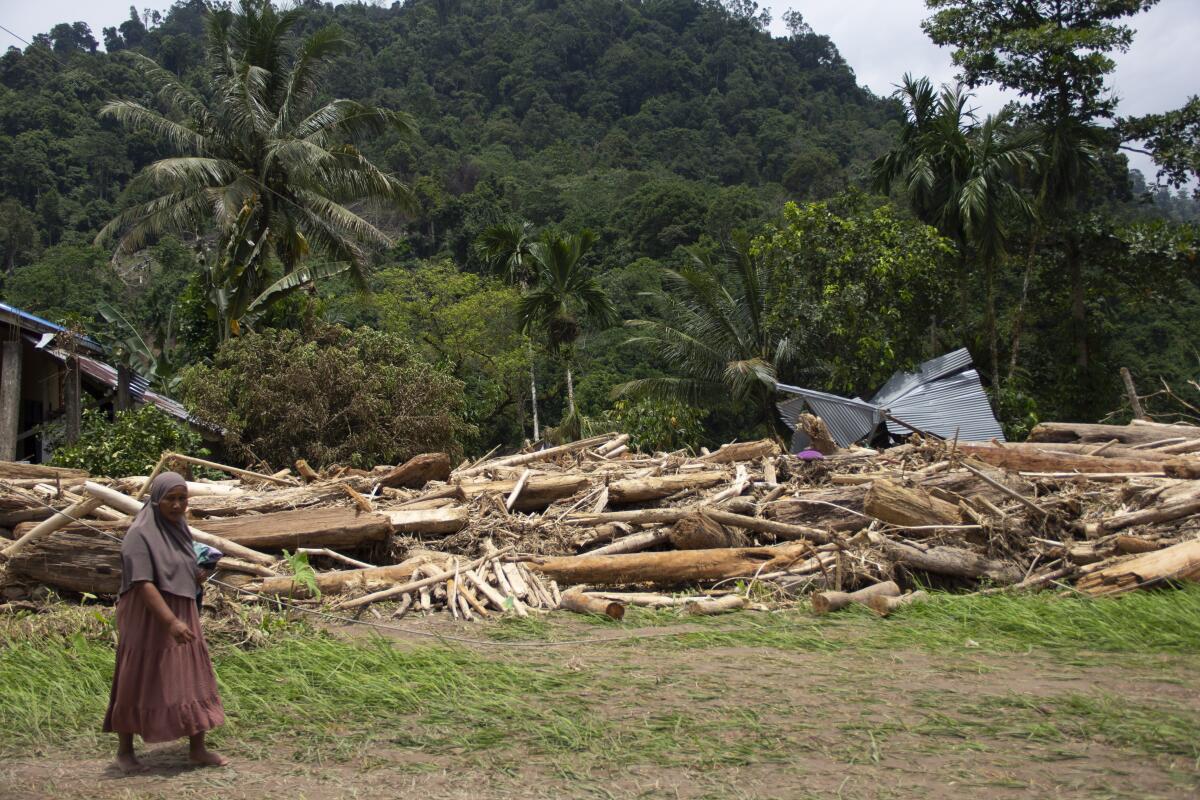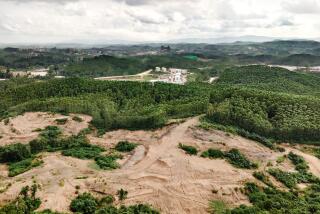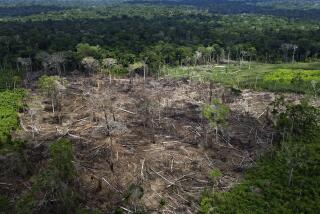In Indonesia, deforestation is intensifying disasters from severe weather, climate change

- Share via
JAKARTA, Indonesia — Roads turned to murky brown rivers, homes were swept away by strong currents and bodies were pulled from mud during deadly flash floods and landslides after torrential rains hit West Sumatra in early March, marking one of the latest deadly natural disasters in Indonesia.
Government officials blamed the floods on heavy rainfall, but environmental groups have cited the disaster as the latest example of deforestation and environmental degradation intensifying the effects of severe weather across Indonesia.
“This disaster occurred not only because of extreme weather factors, but because of the ecological crisis,” Indonesian environmental rights group Indonesian Forum for the Environment wrote in a statement. “If the environment continues to be ignored, then we will continue to reap ecological disasters.”
A vast tropical archipelago stretching across the equator, Indonesia is home to the world’s third-largest rainforest, with a variety of endangered wildlife and plants, including orangutans, elephants, giant and blooming forest flowers. Some live nowhere else.
For generations the forests have also provided livelihoods, food and medicine while playing a central role in cultural practices for millions of Indigenous residents in Indonesia.
Since 1950, more than 285,700 square miles of Indonesian rainforest — an area twice the size of Germany — have been logged, burned or degraded for development of palm oil, paper and rubber plantations, mining and other commodities, according to Global Forest Watch.
Indonesia is the biggest producer of palm oil, one of the largest exporters of coal and a top producer of pulp for paper. It also exports oil and gas, rubber, tin and other resources. And it also has the world’s largest reserves of nickel — a crucial material for electric vehicles, solar panels and other goods needed for the green energy transition.
Toward a more sustainable California
Get Boiling Point, our newsletter exploring climate change, energy and the environment, and become part of the conversation — and the solution.
You may occasionally receive promotional content from the Los Angeles Times.
Indonesia has consistently ranked as one of the largest global emitters of plant-warming greenhouse gases, with its emissions stemming from the burning of fossil fuels, deforestation and peatland fires, according to the Global Carbon Project.
It’s also highly vulnerable to climate change impacts, including extreme events such as floods and droughts, long-term changes from sea level rise, shifts in rainfall patterns and increasing temperatures, according to the World Bank. In recent decades the country has already seen the effects of climate change: more intense rains, landslides and floods during rainy season, and more fires during a longer dry season.
But forests can help play a vital role in reducing the impact of some extreme weather events, said Aida Greenbury, a sustainability expert focusing on Indonesia.
Flooding can be slowed by trees and vegetation soaking up rainwater and reducing erosion. In dry season, forests release moisture that helps mitigate the effects of droughts, including fires.
But when forests diminish, those benefits do as well.
A 2017 study reported that forest conversion and deforestation expose bare soil to rainfall, causing soil erosion. Frequent harvesting activities — such as done on palm oil plantations — and the removal of ground vegetation lead to further soil compaction, causing rain to run off the surface instead of entering groundwater reservoirs. Downstream erosion also increases sediment in rivers, making them shallower and increasing flood risks, according to the research.
After the deadly floods in Sumatra in early March, West Sumatra Gov. Mahyeldi Ansharullah said there were strong indications of illegal logging around locations affected by floods and landslides. That, combined with extreme rainfall, inadequate drainage systems and improper housing development, contributed to the disaster, he said.
Experts and environmental activists have pointed to deforestation worsening disasters in other regions of Indonesia as well: In 2021 environmental activists partially blamed deadly floods in Kalimantan on environmental degradation caused by large-scale mining and palm oil operations. In Papua, deforestation was partially blamed for floods and landslides that killed more than 100 people in 2019.
There have been some signs of progress: In 2018 Indonesian President Joko Widodo, known as Jokowi, put a three-year freeze on new permits for palm oil plantations. And the rate of deforestation slowed in 2021-22, according to government data.
But experts warn that it’s unlikely deforestation in Indonesia will stop anytime soon as the government continues to move forward with new mining and infrastructure projects such as new nickel smelters and cement factories.
“A lot of land use and land-based investment permits have already been given to businesses, and a lot of these areas are already prone to disasters,” said Arie Rompas, an Indonesia-based forestry expert at Greenpeace.
President-elect Prabowo Subianto, who is scheduled to take office in October, has promised to continue Jokowi’s policy of development, include large-scale food estates, mining and other infrastructure development that are all linked to deforestation.
Environmental watchdogs also warn that environmental protections in Indonesia are weakening, including the passing of the controversial Omnibus Law, which eliminated an article of the Forestry Law regarding the minimum area of forest that must be maintained at development projects.
“The removal of that article makes us very worried [about deforestation] for the years to come,” Rompas said.
While experts and activists recognize that development is essential for Indonesia’s economy to continue to go, they argue that it should be done in a way that considers the environment and incorporates better land planning.
“We can’t continue down the same path we’ve been on,” said Greenbury, the sustainability expert. “We need to make sure that the soil, the land in the forest doesn’t become extinct.”
Milko writes for the Associated Press.
More to Read
Sign up for Essential California
The most important California stories and recommendations in your inbox every morning.
You may occasionally receive promotional content from the Los Angeles Times.









